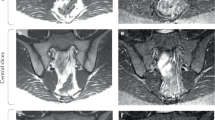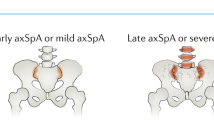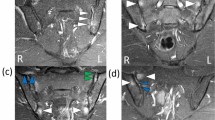Abstract
Sacroiliitis on conventional radiography, a key diagnostic feature of axial spondyloarthritis (SpA), often appears only late in the disease course. With the introduction of potent biologic agents that may also be effective in early disease, diagnostic techniques that can identify SpA early in the disease course would be highly beneficial to patients. MRI has been proposed as a novel diagnostic tool for early axial SpA based on the visualization of active inflammatory lesions in established axial SpA, as well as in pre-radiographic axial SpA. Accordingly, MRI is already widely used in clinical practice and has been included in new classification criteria. However, the specificity and predictive value of MRI lesions for the development of axial SpA remain to be fully defined and validated. Most data come from cross-sectional analyses and have not been validated in prospective studies, and the few available prospective studies were performed in highly selected patient populations and have assessed the value of MRI for the prediction of sacroiliitis rather than axial SpA. Also, some studies have indicated considerable diversity in the pattern and extent of MRI lesions, and suggest that many lesions are not specific for SpA. Prospective, longitudinal studies are needed to validate the utility of this new imaging modality for the diagnosis of axial SpA.
This is a preview of subscription content, access via your institution
Access options
Subscribe to this journal
Receive 12 print issues and online access
$209.00 per year
only $17.42 per issue
Buy this article
- Purchase on Springer Link
- Instant access to full article PDF
Prices may be subject to local taxes which are calculated during checkout
Similar content being viewed by others
References
Dougados, M. et al. The European Spondylarthropathy Study Group preliminary criteria for the classification of spondylarthropathy. Arthritis Rheum. 34, 1218–1227 (1991).
van der Linden, S., Valkenburg, H. A. & Cats, A. Evaluation of the diagnostic criteria for ankylosing spondylitis. A proposal for modification of the New York criteria. Arthritis Rheum. 27, 361–368 (1984).
van Tubergen, A. et al. Radiographic assessment of sacroiliitis by radiologists and rheumatologists: does training improve quality? Ann. Rheum. Dis. 62, 519–525 (2003).
Rudwaleit, M. et al. The early disease stage in axial spondylarthritis: results from the German Spondyloarthritis Inception Cohort. Arthritis Rheum. 60, 717–727 (2009).
Haibel, H. et al. Efficacy of adalimumab in the treatment of axial spondylarthritis without radiographically defined sacroiliitis: results of a twelve-week randomized, double-blind, placebo-controlled trial followed by an open-label extension up to week fifty-two. Arthritis Rheum. 58, 1981–1991 (2008).
Kozin, F., Carrera, G. F., Ryan, L. M., Foley, D. & Lawson, T. Computed tomography in the diagnosis of sacroiliitis. Arthritis Rheum. 24, 1479–1485 (1981).
Fam, A. G., Rubenstein, J. D., Chin-Sang, H. & Leung, F. Y. Computed tomography in the diagnosis of early ankylosing spondylitis. Arthritis Rheum. 28, 930–937 (1985).
Fewins, H. E., Whitehouse, G. H. & Bucknall, R. C. Role of computed tomography in the evaluation of suspected sacroiliac joint disease. J. R. Soc. Med. 83, 430–432 (1990).
Wittram, C., Whitehouse, G. H., Williams, J. W. & Bucknall, R. C. A comparison of MR and CT in suspected sacroiliitis. J. Comput. Assist. Tomogr. 20, 68–72 (1996).
Yu, W. et al. Comparison of radiography, computed tomography and magnetic resonance imaging in the detection of sacroiliitis accompanying ankylosing spondylitis. Skeletal Radiol. 27, 311–320 (1998).
Puhakka, K. B. et al. Imaging of sacroiliitis in early seronegative spondylarthropathy. Assessment of abnormalities by MR in comparison with radiography and CT. Acta Radiol. 44, 218–229 (2003).
Rudwaleit, M. et al. The development of Assessment of Spondyloarthritis International Society (ASAS) classification criteria for axial spondyloarthritis (part I): classification of paper patients by expert opinion including uncertainty appraisal. Ann. Rheum. Dis. 68, 770–776 (2009).
Rudwaleit, M. et al. The development of Assessment of Spondyloarthritis International Society (ASAS) classification criteria for axial spondyloarthritis (part II): validation and final selection. Ann. Rheum. Dis. 68, 777–783 (2009).
Heuft-Dorenbosch, L. et al. Performance of various criteria sets in patients with inflammatory back pain of short duration; the Maastricht early spondyloarthritis clinic. Ann. Rheum. Dis. 66, 92–98 (2007).
Weber, U. et al. The diagnostic utility of MRI in spondyloarthritis: an international multicentre evaluation of 187 subjects (the MORPHO study). Arthritis Rheum. doi:10.1002/art.27571.
Bennett, A. N. et al. Evaluation of the diagnostic utility of spinal magnetic resonance imaging in axial spondylarthritis. Arthritis Rheum. 60, 1331–1341 (2009).
Weber, U. et al. Sensitivity and specificity of spinal inflammatory lesions assessed by whole-body magnetic resonance imaging in patients with ankylosing spondylitis and recent-onset inflammatory back pain. Arthritis Rheum. 61, 900–908 (2009).
Oostveen, J., Prevo, R., den Boer, J. & van de Laar, M. Early detection of sacroiliitis on magnetic resonance imaging and subsequent development of sacroiliitis on plain radiography. A prospective, longitudinal study. J. Rheumatol. 26, 1953–1958 (1999).
Bennett, A. N. et al. Severity of baseline magnetic resonance imaging-evident sacroiliitis and HLA-B27 status in early inflammatory back pain predict radiographically evident ankylosing spondylitis at eight years. Arthritis Rheum. 58, 3413–3418 (2008).
Madsen, K. B., Schiottz-Christensen, B. & Jurik, A. G. Prognostic significance of magnetic resonance imaging changes of the sacroiliac joints in spondyloarthritis—a followup study. J. Rheumatol. 37, 1718–1727 (2010).
Acknowledgements
L. De Rycke and D. Baeten are supported by grants from The Netherlands Organisation for Scientific Research.
Author information
Authors and Affiliations
Contributions
L. De Rycke, M. Maas and D. Baeten researched data for the article. All authors made substantial contributions to discussion of the content. L. De Rycke, P. P. Tak and D. Baeten wrote the article. All authors contributed to review/editing of the manuscript before submission.
Corresponding author
Ethics declarations
Competing interests
The authors declare no competing financial interests.
Rights and permissions
About this article
Cite this article
De Rycke, L., Maas, M., Tak, P. et al. 'MRI-tis' in the early diagnosis of axial SpA: issues and limitations. Nat Rev Rheumatol 6, 666–669 (2010). https://doi.org/10.1038/nrrheum.2010.161
Published:
Issue Date:
DOI: https://doi.org/10.1038/nrrheum.2010.161
This article is cited by
-
Sacroiliac joint MRI for diagnosis of ax-SpA: algorithm to improve the specificity of the current ASAS MRI criteria
European Radiology (2023)
-
MRI of the axial skeleton: differentiating non-inflammatory diseases and axial spondyloarthritis: a review of current concepts and applications
La radiologia medica (2019)
-
Prevalence of degenerative and spondyloarthritis-related magnetic resonance imaging findings in the spine and sacroiliac joints in patients with persistent low back pain
European Radiology (2016)
-
Osteoimmunology and osteoporosis
Arthritis Research & Therapy (2011)
-
Justification for including MRI as a tool in the diagnosis of axial SpA
Nature Reviews Rheumatology (2010)



